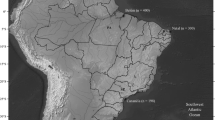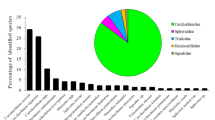Abstract
Eels are a taxonomic group with great commercial importance due to their huge steaks. They have very high demand, especially the young ones. There are high morphological similarity and different market values between different species. For these reasons arises the need to develop techniques that allow identifying as many species as possible. In this study, a DNA method based on DNA phylogenetic analysis of sequences (forensically informative nucleotide sequencing) has been developed. This method has been used to authenticate 12 eel species, including the most important to commercial level (Anguilla anguilla, A. rostrata, A. japonica, A. australis), by means of the amplification of a 239-base pair (bp) fragment of the mitochondrial Cytochrome b (cyt b) gene. This method is useful to clarify questions related to the correct labeling of commercial products and to verify the traceability in commercial trade and for fisheries control.



Similar content being viewed by others
References
Hardy JD (1978) Development of fishes of the Mid-Atlantic Bight: an atlas of Egg, Larval, and Juvenile stages. Anguillidae thorough Syngnathidae. In: Fish and Wildlife Service. Department of the Interior, U.S., p 455
Dekker W (2003) On the distribution of the European eel (Anguilla anguilla) and its fisheries. Can J Fish Aquat Sci 60:787–799
FAO (2003) Fishery and aquaculture statistics
Lobon-Cervia J (1999) The decline of eel Anguilla anguilla (L.) in a river catchment of northern Spain 1986–1997. Further evidence for a critical status of eel in Iberian waters. Arch Hydrobiol 144:245–253
Moriarty C (1996) The decline in catches of European elver of 1980–1992. Arch Pol Fish 4:245–248
Boubee JA, Mitchell CP, Chisnall BL, West DW, Bowman EJ, Haro A (2001) Factors regulating the downstream migration of mature eels (Anguilla spp,) at Aniwhenua Dam, Bay of Plenty, New Zealand. N Z J Mar Freshw Res 35:121–134
EU. Council Regulation (EC) No 1100/2007 of 18 September 2007 establishing measures for the recovery of the stock of European eel
Minegishi Y, Aoyama J, Inoue JG, Miya M, Nishida M, Tsukamoto K (2005) Molecular phylogeny and evolution of the freshwater eels genus Anguilla based on the whole mitochondrial genome sequences. Mol Phylogenet Evol 34:134–146
Jamandre BWD, Shen KN, Yambot AV, Tzeng WN (2007) Molecular phylogeny of Philippine freshwater eels anguilla spp. (Actinopterygi: Anguilliformes: Anguillidae) inferred from mitochondrial. Raffles Bull Zool 14:51–59
Sezaki K, Itoi S, Watabe S (2005) A simple method to distinguish two commercially valuable eel species in Japan Anguilla japonica and A-anguilla using polymerase chain reaction strategy with a species-specific primer. Fish Sci 71:414–421
Aoyama J, Watanabe S, Nishida M, Tsukamoto K (2000) Discrimination of catadromous eels of genus Anguilla using polymerase chain reaction-restriction fragment length polymorphism analysis of the mitochondrial 16S ribosomal RNA domain. Trans Am Fish Soc 129:873–878
Hwang DF, Jen HC, Hsieh YW, Shiau CY (2004) Applying DNA techniques to the identification of the species of dressed toasted eel products. J Agric Food Chem 52:5972–5977
Kim WJ, Kong HJ, Kim YO, Nam BH, Kim KK (2009) Development of RAPD-SCAR and RAPD-generated PCR-RFLP Markers for Identification of Four Anguilla eel Species. Animal Cells Syst 13:179–186
Lin YS, Poh YP, Lin SM, Tzeng CS (2002) Molecular techniques to identify freshwater eels: RFLP analyses of PCR-amplified DNA fragments and allele-specific PCR from mitochondrial DNA. Zool Stud 41:421–430
Rehbein H, Sotelo CG, Perez-Martin RI, Chapela-Garrido MJ, Hold GL, Russell VJ, Pryde SE, Santos AT, Rosa C, Quinteiro J, Rey-Mendez M (2002) Differentiation of raw or processed eel by PCR-based techniques: restriction fragment length polymorphism analysis (RFLP) and single strand conformation polymorphism analysis (SSCP). Eur Food Res Technol 214:171–177
Frankowski J, Bastrop R (2009) Identification of Anguilla anguilla (L.) and Anguilla rostrata (Le Sueur) and their hybrids based on a diagnostic single nucleotide polymorphism in nuclear 18S rDNA. Mol Ecol Resour 10:173–176
Itoi S, Nakaya M, Kaneko G, Kondo H, Sezaki K, Watabe S (2005) Rapid identification of eels Anguilla japonica and Anguilla anguilla by polymerase chain reaction with single nucleotide polymorphism-based specific probes. Fish Sci 71:1356–1364
Minegishi Y, Yoshinaga T, Aoyama J, Tsukamoto K (2009) Species identification of Anguilla japonica by real-time PCR based on a sequence detection system: a practical application to eggs and larvae. Ices J Marine Sci 66:1915–1918
Watanabe S, Minegishi Y, Yoshinaga T, Aoyama J, Tsukamoto K (2004) A quick method for species identification of Japanese eel (Anguilla japonica) using real-time PCR: An onboard application for use during sampling surveys. Mar Biotechnol 6:566–574
Maes GE, Pujolar JM, Raeymaekers JAM, Dannewitz J, Volckaert FAM (2006) Microsatellite conservation and Bayesian individual assignment in four Anguilla species. Marine Ecol Prog Ser 319:251–261
Lehmann D, Hettwer H, Taraschewski H (2000) RAPD-PCR investigations of systematic relationships among four species of eels (Teleostei: Anguillidae), particularly Anguilla anguilla and A-rostrata. Mar Biol 137:195–204
Takagi M, Taniguchi N (1995) Random amplified polymorphic DNA (Rapd) for identification of 3 species of Anguilla, Anguilla-Japonica, Anguilla-Australis and Anguilla-Bicolor. Fish Sci 61:884–885
Roger SO, Bendich AJ (1988) Extraction of DNA from plant tissues. Plant Mol Biol Manual A6:1–10
Winfrey MR, Rott MA, Wortman AT (1997) UnraVeling DNA: molecular biology for the laboratory. Prentice Hall, New York
Hall TA (1999) BioEdit: a user-friendly biological sequence alignment editor and analysis program for Windows 95/98/NT. Nucl Acids Symp Ser 41:95–98
Mc Carthy C (1996) Chromas version 1.45. School of Health Science, Griffifth University, Gold Coast Campus, Queensland, Australia
Thompson JD, Gibson TJ, Plewniak F, Jeanmougin F, Higgins DG (1997) The CLUSTAL_X windows interface: flexible strategies for multiple sequence alignment aided by quality analysis tools. Nucleic Acids Res 25:4876–4882
Tamura K, Dudley J, Nei M, Kumar S (2007) MEGA4: molecular evolutionary genetics analysis (MEGA) software version 4.0. Mol Biol Evol 24:1596–1599
Saitou N, Nei M (1987) The neighbor-joining method—a new method for reconstructing phylogenetic trees. Mol Biol Evol 4:406–425
Espiñeira M, Gonzalez-Lavin N, Vieites JM, Santaclara FJ (2009) Development of a method for the identification of scombroid and common substitute species in seafood products by FINS. Food Chem 117:698–704
Espiñeira M, Vieites JM, Santaclara FJ (2009) Development of a genetic method for the identification of salmon, trout, and bream in seafood products by means of PCR-RFLP and FINS methodologies. Eur Food Res Technol 229:785–793
Bartlett SE, Davidson WS (1992) FINS (forensically informative nucleotide sequencing): a procedure for identifying the animal origin of biological specimens. Biotechniques 12:408–411
Tamura K, Nei M (1993) Estimation of the number of nucleotide substitutions in the control region of mitochondrial-DNA in humans and chimpanzees. Mol Biol Evol 10:512–526
Hillis DM, Bull JJ (1993) An empirical-test of bootstrapping as a method for assessing confidence in phylogenetic analysis. Syst Biol 42:182–192
Acknowledgments
We thank Mar Huertas (Algarve University of Portugal), Dalius Butkauskas (Nature Research Center of Lituania), Le Quang Dung (Institute of Marine Environment and Resources of Vietnam), Caroline Coté (Canada), David Cairns (Department of Fisheries and Oceans of Canada), Yves de Lafontaine and Simon Despatie (Aquatic Ecosystems Division. Environnement of Canada).
Author information
Authors and Affiliations
Corresponding author
Rights and permissions
About this article
Cite this article
Lago, F.C., Vieites, J.M. & Espiñeira, M. Authentication of the most important species of freshwater eels by means of FINS. Eur Food Res Technol 234, 689–694 (2012). https://doi.org/10.1007/s00217-012-1672-4
Received:
Revised:
Accepted:
Published:
Issue Date:
DOI: https://doi.org/10.1007/s00217-012-1672-4




